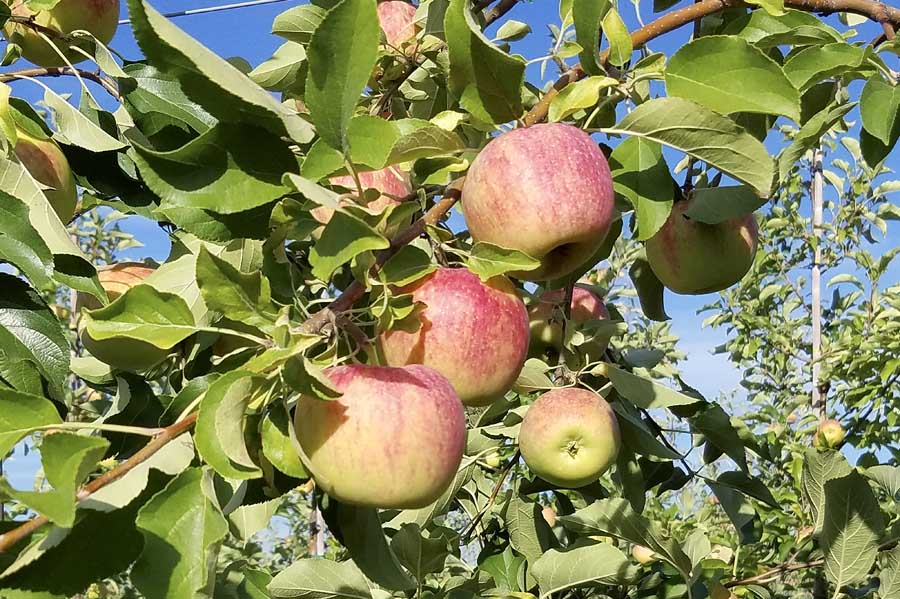
Sun Orchard Fruit Co., Honeybear Brands’ exclusive Eastern U.S. packing partner, will pay a premium for Pazazz apples, similar to those paid for Honeycrisp or other club varieties.(Courtesy Dan Pettit)
Seeing the potential for high returns, PettitFarms of Medina, New York, committed five ofits 100 acres of apples to Pazazz.
The Honeybear Brands club variety commands a premium, close to Honeycrisp or other club varieties, according to Tim Mansfield, director of marketing and sales for Sun Orchard Fruit Co. of Burt, New York, the exclusive packer in the Eastern United States.
And that’s how Pettit Farms first heard of the apple.
“We’ve been doing business with Sun Orchard for 40 years,” said Dan Pettit, an owner and general manager who made the decision with his Pettit Farms partners — his dad, Charles, his uncle, Thomas Pettit, and Matt Crandall, a full-time employee.
Pettit likes Pazazz’s harvest time, because prior to planting it, the farm devoted late September and early October to picking Empires.
“The returns for Empires are not as favorable as they are for some varieties,” he said. Pettit shared his experiences growing Pazazz during the 2016 International Fruit Tree Association’s New York Study Tour in July.
Getting started
The farm’s first and second plantings are 4 and 3 years old. Rows are 12 feet apart with 2.5 feet between trees on a three-wire trellis with bamboo stakes for vertical support.
They procured trees for the first planting from a local grower and, for the later one, from a Washington grower. All Pazazz propagation is done under the authority and direction of Willow Drive Nursery of Ephrata, Washington.
Trees from both sources grew on Nic.29 rootstock. Because the nurseries weren’t familiar with the trees’ growth habits, they chose a vigorous one. “If we were to do it again, we’d possibly try the less vigorous B.9,” Pettit said.
They planted the trees on their best ground — cropland converted to orchards that retain moisture and is tile-drained. Outside of their placement, the trees get no special treatment.
In years one and two, the Pettits applied 200 pounds of calcium nitrate twice a year — when the trees began to green and again a month later. For year three, they applied 100 pounds twice.
“In year four, we did none; that’s sort of an experiment we have going on our farm,” he said. “Pazazz has that large fruit size and our thought was, by reducing the nitrogen, it would help to reduce that fruit size.” Pazazz wants to be a big apple, especially in early plantings, Mansfield said. “Over time, the sizing will moderate, but these young trees want to put out large retail-sized fruit when they first get going.”
Easy keeper
Don Roper, Honeybear Brands marketing vice president, said the variety lends itself to conventional practices, though Washington growers are doing well with it in organic operations, too. “In the East, it fares much better when grown conventionally, due to the challenges of the region’s moisture-rich environment,” he said.
Pettit said it’s an easy tree to grow. They use bamboo for vertical support to guide leaders but he thinks the trees don’t need them. “I’m not sure they’re necessary because it does grow wild, like a bush,” he said.
Pruning demands are no different for Pazazz either. The Pettits make five cuts every year on all their trees.
Thinning wasn’t an issue this year mostly because of the previous spring’s weather. Pettit Farms didn’t escape the early warming week in late March, followed by the deep freeze in early April that afflicted most of the Northeast this year. “If we had thinned, I don’t think we’d get much of a crop,” Pettit said.
In the second year, they were just looking to get the blooms off the tree. They applied one-half pint of carbaryl per 100 gallons this year. “It turned out well,” he said.
They haven’t embraced mechanization, although they narrow their tree shape into what Pettit describes as a tall, slender spindle. Fruit is generally no farther than 2 feet from the trunk.
Pazazz growers must be careful to not over-crop limbs. “If you over-crop limbs, they have a tendency to rip off,” he said. “Planting the trees closer together might be a good thing, keeping the fruit in.”
In last year’s harvest on 3-year-old trees, they picked twice, taking 80 percent of the fruit the first time. Seven days later, they picked the rest.
The Pettits thought they might have bitter pit problems, given that Honeycrisp is one of the parents of Pazazz, and they did in their younger trees. “Our second-year crop was riddled with it, but our third-year crop had very little,” he said.
Postharvest
This will be Sun Orchards’ second year marketing the apple, with 10 Eastern U.S. growers currently.
“It has a good, complex flavor that should sell well,” Mansfield said.
The apple’s acid is high at harvest. “Similar to Pink Lady, it needs to sit in storage for up to a month to reach an optimal balance between acid and sugar,” he said, but added that coming out of storage, the apple should sell well through July.
Roper said Honeybear Brands sold Pazazz to 24 markets last year, and he predicted the company will double that number in 2016 because production from all four growing zones will provide more volume. Pazazz is grown in Washington, Minnesota, New York and Nova Scotia, with test plantings in Chile and New Zealand. •






Leave A Comment